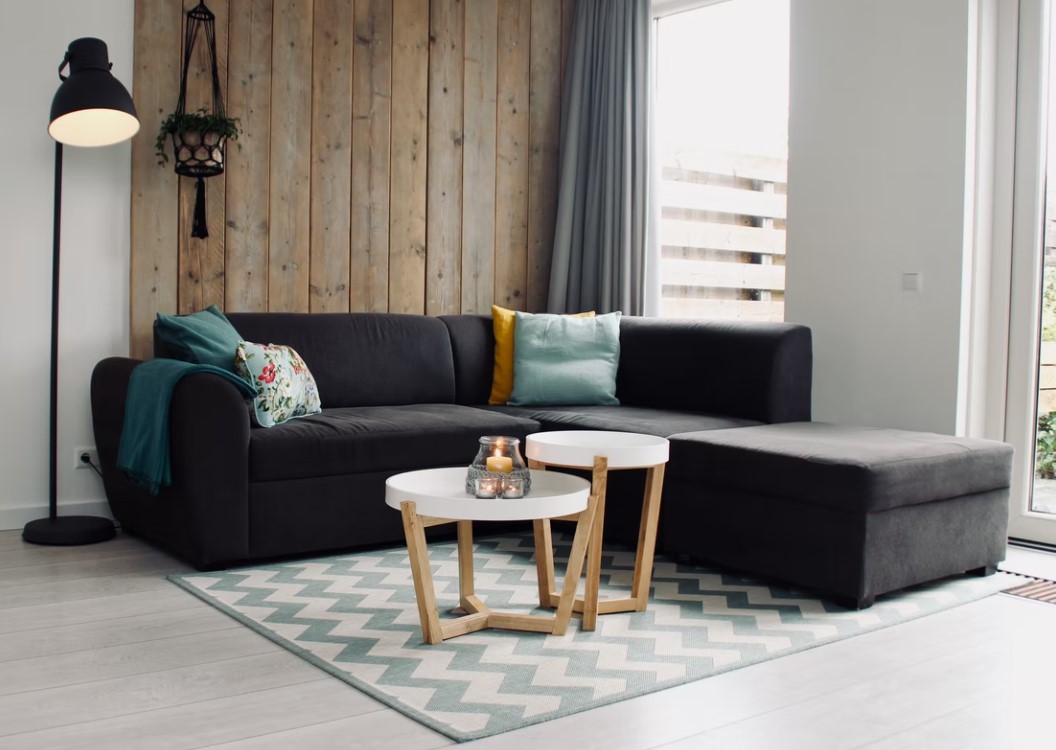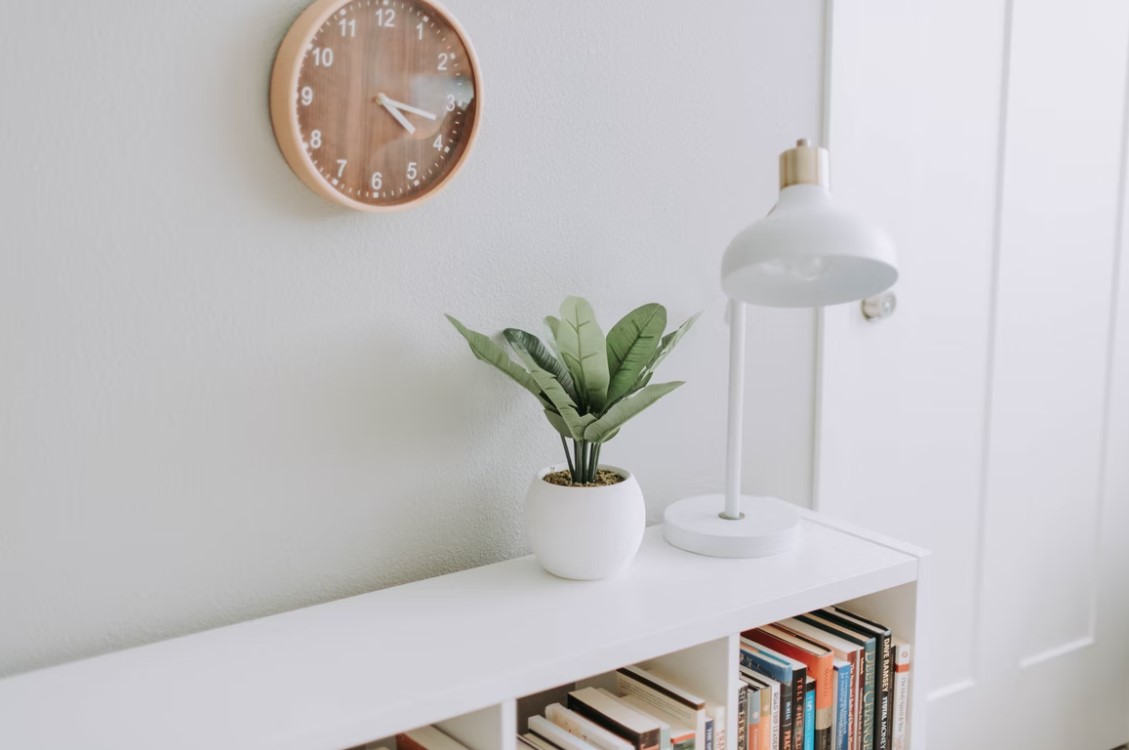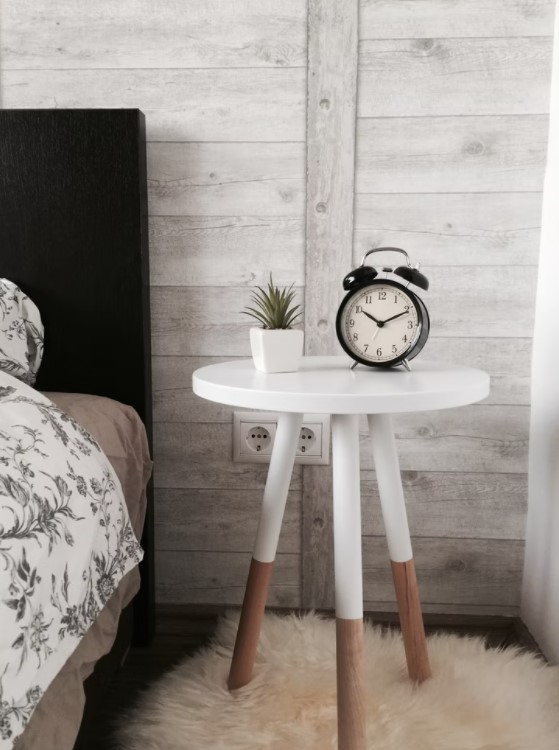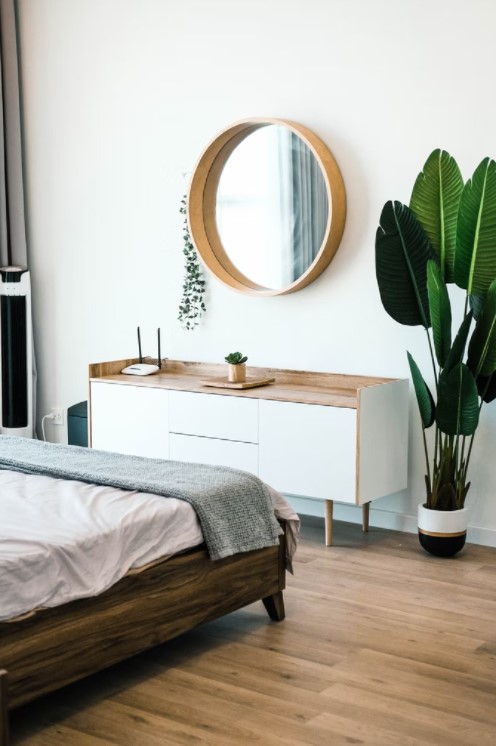Mixing white and dark wood furniture in living room Mixing wood tones is hard enough. Mixing white and dark wood tones, though – that takes some real skill and balance to pull it off.
And when you have the idea to mix dark wood pieces with white wood tones in your living room, it’s even more important that you get it right.
Today we’re going to explain it all so you can mix your dark wood furniture and white wood furniture at home.
Contents
Understanding wood tones

Understanding wood tone and knowing how to mix wood tones in a subtle but effective way is important – usually.
But with dark wood and white wood, the contrasting wood tones aren’t subtle at all. But they still need balance.
So, different wood tones, what do you need to know?
Dominant wood tone

Your dominant wood tone is picked up from your wood floors or your largest piece of wood furniture.
For example, in the dining room, the dominant tone would be the wood tone of your dining table. In the living room, the dominant tone would be the wood tone of your wooden coffee table or the wood accent of your statement armchair and sofa.
This dominant wood tone is what’s going to allow you to mix in dark wood and white wood pieces effectively.
Since you’re only interested in dark wood pieces and white wood pieces today, your dominant wood tone will be one of these.
That’s important – because whichever one is dominant will need to remain dominant. You’re not looking for a 50/50 split. You need one to anchor the other.
Read More : How to decorate an empty rented house living room without spending too much money
Undertones
When mixing wood tones, it’s the undertones that are important. The family the wood tones belong to. And there are 3:
- Cool
- Warm
- Neutral
What’s important for today’s post is knowing that dark and white wood can fall into any of these 3.
Use a wood swatch to determine which category your dominant wood tone falls into, and then only select the opposite wood color furniture that fits into the same category.
Ordinarily contrasting wood tones and their families work, but you’re already getting the contrast in your living room from the dark and white wood fun mix.
So, choose wood colors that stay within the same tones. If it’s warm tones, match that. And so on.
Mixing wood furniture finishes

You don’t always need to think about tones, so long as you match wood finishes and wood grains. But today, your focus is on the tones for your living room, so the finishes and grains don’t matter.
What does that mean?
You can have fun with it! Mixing wood finishes means you can try new furniture styles and use different wood surfaces and textures to experiment in the space.
A wood finish can work with your hardwood floors or against them when using dark and white wood to contrast, so get experimenting. If the interior designers can experiment with different wood finishes, we can too!
Read More : lake house beach ideas
Colors matter

In home decor generally, colors matter. You don’t want an exact match because different shades bring in visual interest and help create continuity. An accent color works well too in any living room.
But today, colors matter even more! There is no magic formula or tips for mixing dark and white furniture that means you’ll get it right every time.
But the real secret to your success is in keeping it simple. Obviously, you don’t have to worry about the same wood tone dragging down your space since they’re so different, but you do need to worry about colors.
The more inspiration you can bring to your new house with other pieces of furniture with various wood tones and color, the better. But don’t overdo it just use functional items like these white drinks cabinets.
If you have a pure white wood coffee table, light wood floors, and new end tables you want to put in – then by all means opt for a creamy white finish for more interest. But stop there. Don’t then get an off white slipcovered sofa with almost-grey upholstery to confuse the space more.
Colors matter, even when you’re Mixing white and dark wood furniture in living room, because too many color options with these different wood tones will confuse the room entirely.
How do you get different colored white and dark furniture?
When dealing in the black and white area of furniture, you might be confused about how you get different wood tones out of these similar colors.
And the secret is wood stain. You can find the usual, oak, walnut, etc., but you can also stain your wood to be dark or white.
A DIY project would work great here, so you can take a new piece of furniture and make it work with the other pieces in your space by staining it yourself at home to mix and match the style.
Mixing wood tones in your living room: A prime example

To help you envision mixing wood tones that are dark and white more, we’ll walk you through an example below.
Picking up on dominance
First step is knowing the dominant wood tone. Let’s say we’re standing in our living room, which has white wood floors, a white wood trim around the walls, and the rest is empty.
We know our dominant wood tone is white.
Now grab a wood swatch
Now take your wood swatch and determine the family this white wood is in. Let’s say it’s cool.
Picking out new pieces
OK, so now we know we’re looking for wood tones that are cool, so when we mix wood tones (in this case, the extreme versions of dark and white wood) we’ll be looking in the cool family of wood tones only.
So let’s think furniture:
- Coffee table: maybe we want our coffee table to contrast a little – so this can be a dark (but cool) wood piece.
- Side tables: maybe now we want to contrast with our coffee table, so our side tables fall back in that white cool wood tone department, but can be a different shade.
- Sideboard: now we might pick up the darker wood again (it doesn’t have to be the same, though) so let’s opt for a cool darker wood tone here too.
- Area rug: we have a lot of different wood tones now, and a rug can tie everything together from the wood floors to the furniture that’s standing on it. So, keep it simple with a nice rug.
Read More : 19 Best RV Dinette
Round-up
As you can see from the example above, there are no fast rules when mixing wood tones that are dark and white. Sometimes you just have to go with the flow.
Just keep your wood floors in mind, your dominant wood tones, and then focus on the undertone families to create continuity.
If you do that, your living room will be a well-balanced mix of style all in one space.





